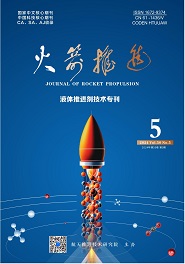航天推进技术研究院主办
ZHANG Yan,KANG Xiao-lu,QIAO Cai-xia.Heaterless hollow cathode for electric propulsion[J].Journal of Rocket Propulsion,2014,40(02):59-66.
一种无加热器的电推进用空心阴极
- Title:
- Heaterless hollow cathode for electric propulsion
- 分类号:
- V439+.4-34
- 文献标志码:
- A
- 摘要:
- 电推力器在国际上已得到广泛应用。目前应用的电推力器,启动时间较长,无法用于需要快速响应的场合。空心阴极是造成电推力器启动时间较长的根本原因。无加热器阴极是一种新型空心阴极,可使得电推力器的启动时间缩短至1 s之内,大大提升电推进系统的响应特性,而且还可以提高电推进系统的稳态工作性能和可靠性。本文介绍无加热器阴极的基本工作原理和应用优势,详细论述无加热器阴极的研究进展,提出突破无加热器阴极技术需要攻克的关键技术。
- Abstract:
- Electric thrusters have been widely used in the world. However, by far the key disadvantage of electric thrusters is that their start time is too long, so they cannot be used in the missions which need fast ignition. The primary reason why the electric thrusters have long ignition time is caused by the hollow cathode assembly. The heaterless hollow cathode is a novel hollow cathode, which can make the electric thruster started in less than 1 s, and improve the response characteristics, stable-state operating performance and reliability of the electric propulsion system. The working principle and advantages of the heaterless hollow cathode are introduced in this paper. The research progress of the heaterless hollow cathode is elaborated. At the end, the key points of the technology which are required to develop this kind of hollow cathode are given.
参考文献/References:
[1]ARKHIPOV B A. Development and research of heaterless cathode-neutralizer for linear hall thrusters (LHD) and plasma ion thrusters (PIT), IEPC-1997-175[R]. USA: IEPC, 1997.
[2]MURASHKO V M, KORYAKIN A I. Russian Flight Hall Thrusters SPT-70 & SPT-100 after cathode change start during 20~25 ms, IEPC-2007-62[R]. USA: IEPC, 2007.
[3]GORSHKOV O A, ARKHIPOV B A, ANFIMOV N A, et al, Overview of Russian activities in electric propulsion, AIAA-2001-3229[R]. USA: NASA, 2001.
[4]BILAN M V, BILOKON V I, KOSHELEV M M, et al. Electric propulsion systems with fast non-incandescent start, IEPC-2003-319 [R]. USA: IEPC, 2003.
[5]LOYAN A, KOSHELEV N. The Results of researching of low-current selfheated hollow cathodes on electric current range from 0.3 up to 0.5 A, IEPC-2001-272[R]. USA: IEPC, 2001.
[6]LOYAN A, KOSHELEV N, RIBALOV O. Results of tests of high-current cathode for high-power Hall thruster, IEPC-2011-197[R]. USA: IEPC, 2011.
[7]LOYAN A, ORANSRIY A, ICHENKO E. High-current self-heated hollow cathodes with operation current more than 25 A: state and development, IEPC-2001-273[R]. USA: IEPC, 2001.
[8]KOROTEEV A S, PELROSOV V A, BARANOV V I. Development of 4 kW HALL-type electric thruster, IEPC- 1993-225[R]. USA: IEPC, 1993.
[9]SCHATZ M F. Heaterless Ignition of Inert Gas Ion Thruster Hollow Cathodes, A86-17833[R]. USA: NASA, 1986.
[10]RUBIN B, WILLIAMS J D. Hollow cathode discharge initiation and fast starting cathode, IEPC-2009-026[R]. USA: IEPC, 2009.
(编辑:王建喜)
[3]吴继平. 高增压比多喷管超声速引射器设计理论、方法与实验研究[D]. 长沙: 国防科技大学, 2007.
[4]吕辉强. 二维超声速空气引射器理论与实验研究[D]. 长沙: 国防科技大学, 2008.
[5]张忠利. 液体火箭发动机自引射工作过程气动传热研究[D]. 西安: 西北工业大学, 2010.
[6]王成鹏. 非对称来流条件下超燃冲压发动机隔离段气动特性研究[D]. 南京: 南京航空航天大学, 2005.
[7]徐万武, 谭建国, 王振国. 高空模拟试车台超声速引射器数值研究[J]. 固体火箭技术, 2003, 26 (2): 71-74.
[8]潘锦珊, 气体动力学基础[M]. 西安: 西北工业大学出版社, 1986.
[9]贺军科, 吴雄. 被动式引射器内流场数值研究[J]. 固体火箭技术, 2005, 28(2): 116-119.
[10]陈健, 吴继平, 王振国, 等. 高空模拟试车台主被动引射方案数值研究[J]. 固体火箭技术, 2011, 34(1): 126- 130.
[11]徐万武, 王振国. 环型超声速空气引射器二次流流场数值研究[J]. 推进技术, 2003, 24(1): 36-39.
[12]吴继平, 陈健, 王振国. 带二次流的多喷管超声速引射器性能实验研究[J]. 强激光与粒子束, 2007, 19(9): 1439-1443.
[13]吴继平, 王振国. 第二喉道超声速引射器启动性能理论研究[J]. 航空动力学报, 2008, 23(5): 803-809.
[14]张忠利. 超音速二次喉道扩压器气动特性研究[J]. 火箭推进, 2001, 27(3): 14-22.
相似文献/References:
[1]张 岩,康小录,乔彩霞.钡钨空心阴极放电等离子体特性实验研究[J].火箭推进,2014,40(05):55.
ZHANG Yan,KANG Xiao-lu,QIAO Cai-xia.Experimental investigation for discharge plasma
properties of BaW hollow cathode[J].Journal of Rocket Propulsion,2014,40(02):55.
备注/Memo
收稿日期:2013-12-04;修回日期:2014-01-22 作者简介:张岩(1988—),男,硕士,研究领域为空间电推进技术
